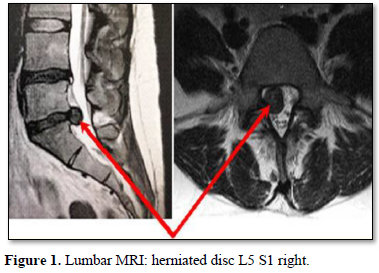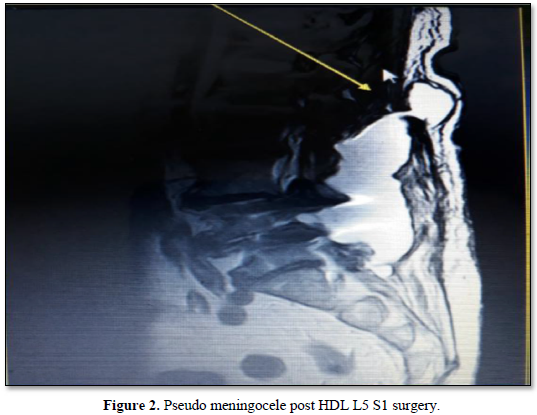Case Report
Post-Surgical Lumbar Pseudomeningocele One Year After Lumbar Disc Hernia Surgery Case Report and Literature Review
4178
Views & Citations3178
Likes & Shares
Pseudomeningocele is a rare complication of spine Surgery, and it is the collection of cerebrospinal fluid in paraspinal tissues. It is usually occult in presentation, and patients do not have any symptoms ascribable to it. We came across one symptomatic patient with post laminectomy pseudomeningocele in past one year at our institution.
Case report: One year after surgery for a Lumbar disc hernia L5-S1 the patient consults again for low back pain and a lumbar subcutaneous mass. Lumbar MRI confirms the diagnosis of pseudo-meningocele, showing fluid formation of the soft parts, postero-spinal on the path of the first approach, thin-walled, without signs of superinfection.
Conclusion: Reappearance of neurological symptoms in a patient undergoing spine surgery previously needs careful evaluation. Rarely the symptoms of failed back surgery are seen to be arising due to a pseudomeningocele.
Keywords: Pseudo-meningocele, Lumbar disc hernia surgery
INTRODUCTION
Post-surgical meningocele is an early complication, represented by a fluid collection of the paraspinal soft tissues, its frequency is estimated at 1 - 13%, it is twice as frequent in herniated disc revisions [1-6].
CASE REPORT
This is a 52-year-old patient with hyperalgesic right S1 low back sciatica. MRI of the lumbosacral spine revealed a right L5 S1 lumbar disc herniation (Figure 1). The patient was operated. The operative suites are simple.


One year, after the surgical treatment, the patient consults again for low back pain and a lumbar subcutaneous mass. Lumbar MRI confirms the diagnosis of pseudo-meningocele, showing fluid formation of the soft parts, postero-spinal on the path of the first approach, thin-walled, without signs of superinfection (Figure 2).
The patient benefited from a surgical revision, with repair of the dural breach, the evolution is favorable.
DISCUSSION
Post-surgical pseodomeningocele is an immediate post-operative complication, it is around 13% after herniated disc surgery [2] and 23% after surgery for ductal stenosis [6]. It is characterized:

- clinically, by postural headaches, simple low back pain, a palpable subcutaneous mass, an intracerebral hypotension syndrome. It can be asymptomatic in 60% of cases [3].
- radiologically, the site of communication with the dural sac, the contrast enhancement of the walls, will be specified; if intense and thick we will discuss a superinfection or an abscess of the soft parts, the compressive character on the dural sac, the subcutaneous character; risk of skin fistula, the presence of a root trapped within the collection [4].
CONCLUSION
The occurrence of a post-surgical lumbar meningocele does not alter the functional result at a distance. The out come is favorable in the majority of cases provided that the diagnosis and treatment are rapid.
- Rillardon L, Guigui P, Veil-Picard A, Slulittel H, Deburge A (2003) Long-term results of surgical treatment of lumbar spinal stenosis. Revue deirurgie orthopédique 89: 621-631.
- Sarrazin JL (2003) Imaging of the operated lumbar spine. J Radiol 84(2 Pt 2): 241-250.
- Couture D, Branch Jr CL (2003) Spinal pseudomeningoceles and cerebrospinal fluids fistulas. Neurosurg Focus 15(6): E6.
- McCormack BM, Taylor SL, Heath S, Scanlon J (1996) Pseudomeningocele/CSF fistula in a patient with lumbar spinal implants treated with epidural blood patch and a brief course of closed subarachnoid drainage. A case report. Spine 21(19): 2273-2276.
- Pointillart CV, Vital J-M, Sénégas J (2000) Hematorrachis or extradural spinal hematoma (HER) postoperative compression. Rev Chir Ortho 86: 335-345.
- Otilainen E, Alanen A, Erkintalo M, Helenius H, Valtonen S (1994) Postoperative hematomas after successful lumbar microdiscectomy or percutaneous nucleotomy: A magnetic resonance imaging study. Surg Neurol 41: 98-105.
QUICK LINKS
- SUBMIT MANUSCRIPT
- RECOMMEND THE JOURNAL
-
SUBSCRIBE FOR ALERTS
RELATED JOURNALS
- International Journal of AIDS (ISSN: 2644-3023)
- Oncology Clinics and Research (ISSN: 2643-055X)
- Journal of Forensic Research and Criminal Investigation (ISSN: 2640-0846)
- Journal of Renal Transplantation Science (ISSN:2640-0847)
- International Journal of Clinical Case Studies and Reports (ISSN:2641-5771)
- Journal of Immunology Research and Therapy (ISSN:2472-727X)
- Dermatology Clinics and Research (ISSN:2380-5609)




